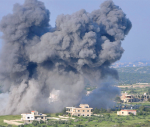You are here
How BLM protests acknowledged Palestinian suffering
Jun 16,2020 - Last updated at Jun 16,2020
“I can’t breathe!” These three words uttered by an African American George Floyd as a Minneapolis police officer forced his knee on his neck on May 25 for more than eight minutes, all recorded on video, have resonated across the United States as well as the rest of the world. Floyd, 46, died as a result of excessive use of force by the police igniting nation-wide protests that entered their 21 day on Monday. The “Black Lives Matter” (BLM) movement soon crossed the Atlantic spreading into European capitals as largely peaceful protesters condemned racism, police brutality, social injustice and colonial history.
Floyd’s death at the hands of the police was not unusual. Last year 235 African Americans were gunned down by police in different circumstances. Until Floyd’s murder, 88 African Americans were reportedly killed in the United States by state police. In fact, as protests raged on across the United States, police shot and killed 27-year-old African American Rayshard Brooks in Atlanta on Friday in what was deemed as a homicide.
The BLM movement has inspired many, and it was inevitable that contrasts be made between the discrimination and brutality against blacks in the West and the treatment of Palestinians by Israeli occupation forces. Palestinians joined US and European protests and raised the Palestinian flag with the slogan “Palestinian Lives Matter”. A mural of Floyd was painted on the separation wall near Bethlehem. The BLM movement became an indictment of all forms of racism, injustice and discrimination around the world. But with Palestine there is a special kinship. On 30 May Eyad Al Halak, a 32-year-old autistic Palestinian was gunned down in cold blood by Israeli soldiers as he walked to his school in the Old City of Jerusalem.
The killing was condemned by Palestinians and Arabs in Israel, and last week the office of the United Nations High Commissioner for Human Rights (OHCHR) called on Israel to swiftly develop to “a full, independent, impartial, competent and transparent investigation into Israeli forces’ killing of a Palestinian man with a mental disability in Jerusalem”, adding that “those responsible must be held to account”.
But Palestinians know that Israel will try to evade responsibility and even if an investigation was to be held it will likely end up in exonerating the soldiers. This is the reality of Palestinians living under occupation: discrimination and excessive use of force with impunity.
Human Rights Watch (HRW), whose representatives are being denied access to the occupied territories, reported last year that between March 30 and November 19, Israeli forces killed 189 Palestinian demonstrators on the border with Gaza, including 31 children and 3 medical workers, and wounded more than 5800 with live fire. Another 37 Palestinians were killed in Gaza during the same period by Israeli air and artillery strikes. Also during the same period HRW reported that Israeli security forces fatally shot 27 Palestinians and wounded at least 5444 in the West Bank, including occupied East Jerusalem.
The organisation, as well as Israeli human rights groups, document other human rights and international law violations by Israel including the demolition of houses, the expropriation of lands and the transfer of Israeli settlers into Palestinian lands. Reports about child incarceration and torture in Israeli prisons are credible.
For decades the Palestinian plight has been eclipsed by Israeli propaganda and the backing of mainly biased US administrations. But with social media and independent groups the Palestinian side of the story is now reaching once indifferent and misinformed western public. The BLM has found an ally in pro-Palestinian activists including the BDS (Boycott, Divestment and Sanctions) movement which last week scored a significant victory when the European Court of Human Rights ruled unanimously said that the highest appeals court in France had the violated the rights of activists with the (BDS) movement when it upheld their criminal convictions in 2015.
And on June 6, 500 law students marched in support of BLM from the State Capitol to the White House and at one point one of the organisers recognised the Palestinian flag and shouted “Free Palestine” as he denounced Israeli apartheid.
This wave of global protests against injustice comes at an awkward time for Israel as it plans its controversial and illegal annexation of Palestinian territory. Many anti-Zionist Jewish activists have been especially active on social media highlighting the fact that Zionism is tantamount to racism. In recent days those activists have pointed to Palestinian suffering and to the fact that Israeli annexation will result in Israel becoming a de facto apartheid state ruling over millions of disenfranchised Palestinians while ushering in a form of modern-day slavery.
It was described by some as the “American Intifada” and the current BLM movement is proving to be the most potent and influential human rights drive since the civil rights marches of the 1960s. The link between BLM and the Palestinian suffering is unbreakable and Israel should not miss the profound impact of the current movement on its own dismal record as it inches further towards more dehumanisation of the Palestinians.
Osama Al Sharif is a journalist and political commentator based in Amman













